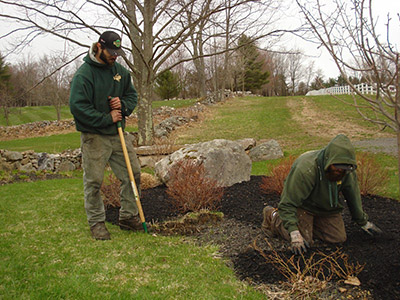Today, businesses are realizing the importance of creating a pleasant and inviting environment for their customers and employees. A well-maintained landscape not only enhances the aesthetics of a commercial property but also contributes to a positive first impression. As the saying goes, "You only get one chance to make a first impression," and that is why landscape maintenance plays a crucial role in the overall image of your business. Whether it’s an office building, a retail store, or a hotel, taking care of your commercial landscape is an art that can elevate the appeal and prestige of your establishment. In this article, we will explore the art of greening and how it can transform your commercial property into an oasis of beauty. Get ready to discover the power of landscape maintenance and the wonders it can bring to your business.
Sustainable Practices for Commercial Landscaping
Sustainable practices play a vital role in maintaining and enhancing commercial landscapes. By implementing eco-friendly strategies, businesses can contribute to the preservation of the environment while creating visually appealing outdoor spaces. When it comes to commercial landscaping, there are several key sustainable practices that can make a significant impact.
Firstly, opting for native plants is an excellent way to promote sustainability in commercial landscaping. Native plants are well-adapted to the local climate and require minimal water and maintenance compared to exotic species. They also provide a habitat for local wildlife, contributing to the overall biodiversity of the area.
In addition to choosing native plants, incorporating efficient irrigation systems is another essential sustainable practice. Installing smart irrigation technology allows for precise and automated watering, reducing water waste and promoting water conservation. This not only benefits the environment but also helps businesses save on water costs in the long run.
Furthermore, the use of organic fertilizers and pest control methods is crucial for maintaining a sustainable commercial landscape. By avoiding harmful chemicals, businesses can ensure that their outdoor spaces are safe for both employees and the environment. Additionally, organic practices promote healthier soil and plants, ultimately leading to a more vibrant and resilient landscape.
By integrating these sustainable practices into commercial landscaping maintenance, businesses can create aesthetically pleasing outdoor environments while minimizing their ecological footprint. Sustainable practices not only contribute to a greener planet but can also enhance the overall image and reputation of a business, attracting environmentally conscious clients and customers.
###Maximizing Curb Appeal through Greenery
In today’s competitive commercial landscape, one key aspect that can truly elevate your property is the strategic use of greenery. By incorporating well-designed landscaping features, you can maximize the curb appeal of your establishment and leave a lasting impression on visitors and potential clients.
The first step in achieving this is to carefully select the right plants and trees that will thrive in your specific environment. Consider the climate, sunlight exposure, and soil conditions of your location to ensure the longevity and vitality of your greenery.
Introducing pops of color through flowering plants can add vibrancy and eye-catching beauty to your landscape. Choose blooms that complement your building’s aesthetic and use them strategically to create focal points that draw attention and create a welcoming atmosphere.
Additionally, integrating vertical greenery can be a game-changer. By adding climbing plants or vertical gardens to walls or trellises, you can transform bare surfaces into stunning visual displays. Not only does this add an element of interest and uniqueness to your property, but it also helps in regulating temperature and improving air quality.
When it comes to the art of greening, remember that maintenance is crucial. Regularly trimming and pruning plants, along with adequate watering and fertilization, will ensure that your landscape remains lush and inviting throughout the year. Proper maintenance not only enhances the overall appearance but also prolongs the life of your greenery.
In conclusion, the art of greening goes beyond mere aesthetics; it is a strategic way to maximize curb appeal. With careful consideration of plant selection, introduction of colorful blooms, incorporation of vertical greenery, and regular maintenance, you can create a captivating landscape that sets your commercial establishment apart.
Implementing Efficient Maintenance Strategies
- Use Native Plants:
One efficient strategy for commercial landscape maintenance is to incorporate native plants into your design. Native plants are well-suited to the local climate and soil conditions, which means they require less water, fertilizer, and overall maintenance. By choosing plants that are naturally adapted to your area, you can reduce the need for intensive care and create a more sustainable landscape.

- Employ Irrigation Techniques:
Efficient irrigation techniques play a crucial role in maintaining a healthy and attractive commercial landscape. By using smart irrigation systems, such as drip irrigation or weather-based controllers, you can ensure that water is delivered directly to the plants’ root zones, minimizing evaporation and water waste. Regular monitoring and adjusting of irrigation schedules can further optimize water usage and reduce overall maintenance efforts.
- Adopt Integrated Pest Management:
Integrated Pest Management (IPM) is a holistic approach to pest control that focuses on prevention, monitoring, and minimal use of pesticides. By implementing IPM principles in your commercial landscaping, you can effectively manage pests while minimizing the impact on the environment. This strategy includes practices such as selecting pest-resistant plants, encouraging natural predators, and utilizing targeted treatments only when necessary. Taking a proactive approach to pest management can help reduce the need for constant maintenance and enhance the overall health of your landscape.
Implementing these efficient maintenance strategies can bring numerous benefits to your commercial landscape. By choosing native plants, employing smart irrigation techniques, and adopting integrated pest management practices, you can create a greener and more sustainable outdoor space that requires less maintenance in the long run.





